Recent Storm Damage Posts
The Role of Snow Removal Services and Storm Cleanup
9/5/2023 (Permalink)
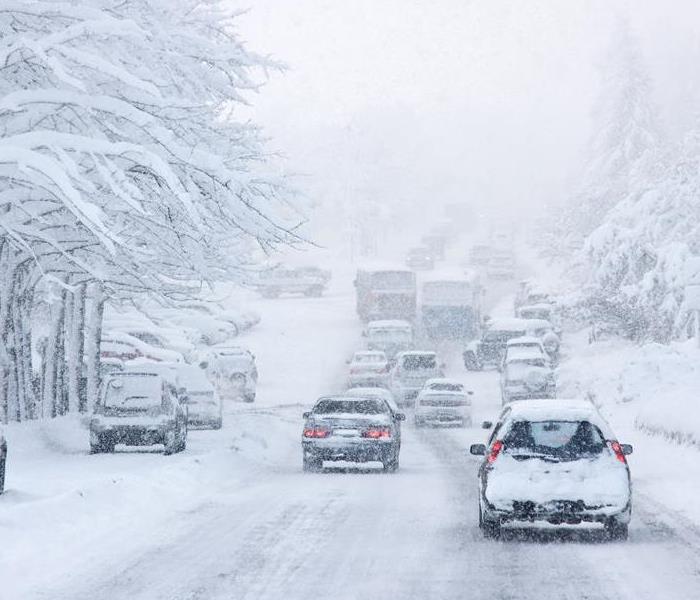 Snow removal is a vital service to ensure roads are safe after a winter storm.
Snow removal is a vital service to ensure roads are safe after a winter storm.
The Northeast is no stranger to severe winter storms and heavy snowfall. These winter weather events can create significant challenges for homeowners and businesses alike. That's where professional snow removal services play a crucial role in the aftermath of a Northeast storm. In this blog post, we will discuss the importance of snow removal services in Northeast storm cleanup and how they help restore normalcy after winter weather events.
Clearing Roads and Pathways
One of the primary roles of snow removal services after a Northeast storm is to clear roads and pathways. Accumulated snow can make roads impassable, leading to traffic congestion and potential accidents. Professional snow removal services have the equipment and expertise to quickly and efficiently clear the snow, allowing for safe travel and enabling emergency services to respond effectively.
Preventing Accidents and Injuries
Snow and ice make surfaces slippery and increase the risk of accidents and injuries. Snow removal services play a crucial role in minimizing these risks by clearing parking lots, sidewalks, and driveways. By removing snow and ice, they create safe walking surfaces, reducing the chances of slips, falls, and other accidents. This is especially important for businesses and municipalities, as they have a responsibility to maintain safe conditions for employees, residents, and visitors.
Preventing Structural Damage
Heavy snowfall can put a significant strain on roofs, especially when it's wet and compacted. Snow removal services help prevent structural damage to buildings by clearing snow from rooftops. By removing excess snow, they relieve the weight on roofs, reducing the risk of collapse and potential damage to the building and its contents. This is particularly important for commercial properties, as roof collapse can lead to business interruption, financial losses, and safety hazards.
Restoring Normalcy
Winter storms can disrupt daily life and disrupt normal routines. Snow removal services play a crucial role in restoring normalcy after a Northeast storm by clearing snow and ice from residential and commercial properties. They enable businesses to resume operations and ensure that homeowners can navigate their properties safely. By quickly and efficiently removing snow, these services help communities recover and get back on track sooner.
Expertise and Equipment
Professional snow removal services have the necessary expertise and equipment to handle even the most challenging winter storms. They have trained personnel who are experienced in snow removal techniques, ensuring that the job is done efficiently and effectively. Additionally, they have access to specialized equipment, such as snowplows, snow blowers, and ice melters, which allows them to tackle large snow accumulations and icy conditions with ease.
Snow removal services play a vital role in the cleanup efforts following Northeast winter storms. They clear roads and pathways, prevent accidents and injuries, prevent structural damage, and help restore normalcy to affected areas. Their expertise and specialized equipment enable them to handle even the most challenging snow and ice conditions. By relying on professional snow removal services, communities and individuals can efficiently and safely recover from winter weather events and continue with their daily lives.
Preparing for the Storm: Developing a Business Continuity Plan
6/5/2023 (Permalink)
Preparing for a storm is essential for any company. Storms can cause extensive damage to homes and businesses, making it crucial to have a business continuity plan (BCP) in place. By having a BCP, your company can ensure that critical services continue to operate during and after a storm, minimizing potential financial losses. In this blog post, we will discuss the steps involved in developing a BCP to prepare for a storm.
Identify key personnel and their roles
The first step in developing a BCP is to identify key personnel and their roles. This includes the people who will be responsible for implementing the plan during and after the storm. For a disaster restoration company, key personnel might include the operations manager, project managers, technicians, and customer service representatives. Each person should have a clear understanding of their role and responsibilities during a storm, such as assessing damage, responding to emergency calls, and coordinating with insurance companies.
Identify critical business functions
Next, identify your company's critical business functions. These are the services that are essential to your company's operations and revenue generation. For a disaster restoration company, critical business functions might include emergency response, damage assessment, water extraction, mold remediation, and reconstruction. It is essential to prioritize these functions and develop a plan to ensure they can continue during and after a storm.
Assess potential risks and impact
Before developing a plan, it is crucial to assess the potential risks and impact of a storm. This includes identifying the types of storms that could affect your area, the likelihood of them occurring, and their potential impact on your business. You should also assess the impact of a storm on your employees, customers, and suppliers, and develop a plan to address these impacts.
Develop a communication plan
Effective communication is critical during a storm. Develop a communication plan that includes how you will communicate with employees, customers, suppliers, and other stakeholders during and after a storm. This should include multiple methods of communication, such as phone, email, text message, and social media.
Develop a recovery plan
Finally, develop a recovery plan to ensure that your company can quickly return to normal operations after a storm. This should include procedures for assessing damage, prioritizing repairs, and restoring critical business functions. It is also essential to communicate with customers and suppliers about your recovery efforts and any potential delays.
In conclusion, developing a BCP is crucial for companies to prepare for a storm. By identifying key personnel and their roles, critical business functions, potential risks, and developing a communication and recovery plan, your company can continue to operate and provide critical services during and after a storm.
5 Landscaping Strategies To Prevent Your Home From Flooding
6/14/2022 (Permalink)
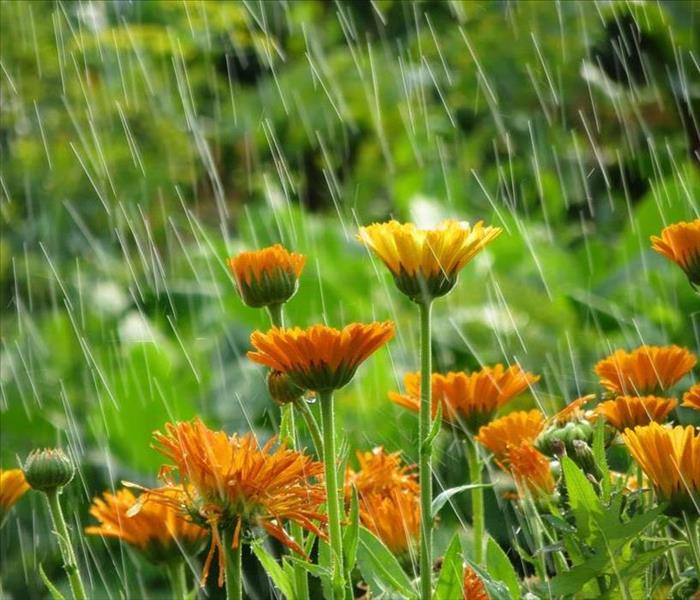 Plant a rain garden.
Plant a rain garden.
Ways To Protect Your Home From Water Damage
Outside flooding due to a severe rain storm can damage your Saxton, PA, home. However, you can protect your home from water damage with the following landscaping solutions.
1. Plant a Rain Garden
Rain gardens are eco-friendly, low-maintenance drainage solutions containing native plant species with deep roots that do not require frequent watering. These gardens collect and retain runoff from impervious surfaces, including
- Patios
- Driveways
- Roofs
- Sidewalks
Strategically placing rain gardens approximately 10 feet from your home creates a barrier protecting your home from flooding.
2. Lay Heavy Mulch
An absorbent layer of mulch over the soil surrounding your home traps rainwater before it can reach your home. Mulch consisting of heavy wood chips will not wash away, and underlying soil erosion is preventable when you divert rain spouts away from your foundation with extenders.
3. Maintain Healthy Grass for Natural Rain Drainage
Healthy grass absorbs large volumes of water and can efficiently prevent outside flooding. Applying fertilizer can strengthen grass root systems and increase their absorbency. Fertilizer also reduces bare patches on your lawn, causing the soil to become impervious to water and promoting flooding.
4. Level Your Yard
Rainwater traveling along the ground that slopes toward your home can quickly accumulate near the foundation before the soil can absorb it. Although plantings along the slope can slow the water's flow, leveling the ground is a better flood prevention strategy.
5. Build a Retaining Wall
Retaining walls can add beauty to your landscape and eliminate flooding by supporting the soil and preventing erosion. They can also accommodate drainage pipes that direct water into the ground away from your home.
Your landscape can play a vital role in protecting your home's exterior and interior from water damage. However, when outside flooding becomes a problem inside your home, a flood mitigation service in Saxton, PA, can clean your space and offer helpful advice about preventing future floods.
4 Sand Bag Alternatives That Will Protect Your Property From Flood Damage
4/22/2022 (Permalink)
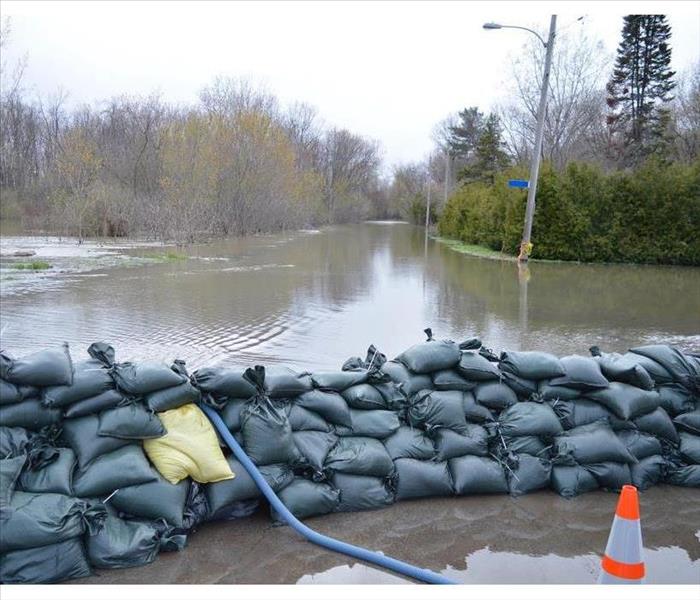 Sandbags can be harder to remove.
Sandbags can be harder to remove.
Alternatives to Sandbags
For decades, business owners have used sandbags to limit flood damage to their properties. After all, they are easy to find and cheap to purchase.
Yet there are downsides to sandbags, as well. For starters, they can be quite heavy. A single sandbag may weigh around 29 pounds. Even if you are able to get the sandbags in place, they can be even harder to remove. That is because they are considered hazardous materials and cannot just be emptied into any Everett, PA, landfill.
Luckily, there are other ways to block floodwater and limit your need for cleanup and restoration services after a storm. Here are some alternatives to sandbags.
1. Plastic Poly Tubes
These long tubes can be filled with dirt or sand to make them higher. They can thus easily block the water from getting past a door. However, as with sandbags, they can be quite difficult to move into place.
2. Garbage Bags
For an inexpensive approach, try filling garbage bags with sand or dirt to create your own sandbag. This can take some time to do, so these bags are best for floods for which you can prepare well in advance. Still, making your own sandbags is cost-effective and should let you put more money back into your business.
3. Transportable Fences
These fences create a barrier that surrounds your premises and blocks water from entering. You can position them where you want, and setting them up does not require too much effort.
4. Flood Dams
You can even fight water with water by purchasing inflatable flood dams. Simply fill up these dams with water and place them around the perimeter of your property. This process is fairly quick and thus works well when you and your employees need to evacuate in a hurry.
When a flood is heading for your building, you do not need to use a sandbag to protect your property. The above alternatives could be just as effective.
How to Avoid Mold Issues in Your Facility
2/22/2022 (Permalink)
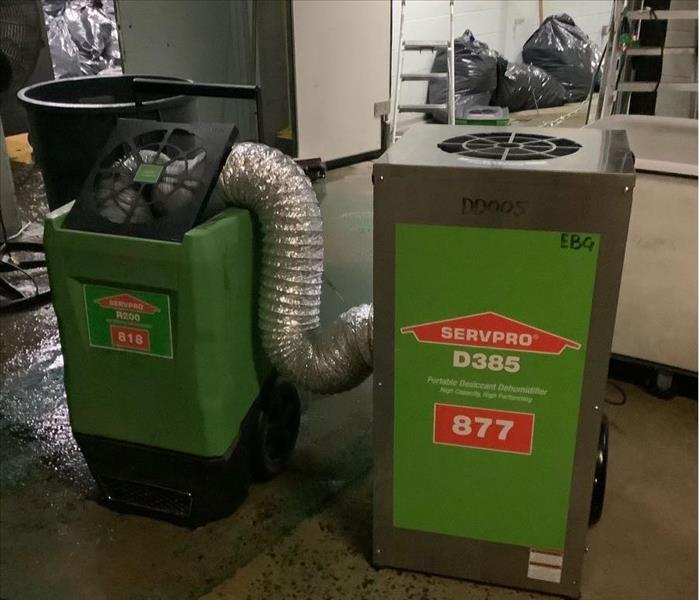 SERVPRO uses a variety of equipment to stabilize air moisture levels and prevent mold growth after storm or water damage!
SERVPRO uses a variety of equipment to stabilize air moisture levels and prevent mold growth after storm or water damage!
Mold is a common issue in commercial buildings. Mold spores are a natural occurrence, and the only thing you can do is try to prevent mold growth in your structure in Bedford or Blair County, PA. Here are three things that you can do to avoid mold problems.
1. Keep the Building Clean
Mold needs food and moisture to survive, which is why you need to maintain a clean and dry environment. Vacuum once a week with a HEPA vacuum. However, how often you need to vacuum depends on how much and what kind of traffic your building sees. Thorough carpet cleaning should be performed at least once a year but more often if your building is highly trafficked. In addition to carpet cleaning, mats at doors for wiping feet should be cleaned and replaced on a regular basis.
2. Perform Regular Maintenance
Fix a leaky plumbing system or leaks in the building envelope as soon as possible to prevent excessive moisture and mold growth. Any condensation or wet spots need to be dried immediately as mold can grow within 24 hours. Have HVAC systems inspected regularly to detect mold or any potential for mold growth early. Part of this maintenance should also be the cleaning of air ducts. Mold can live off of the dust that collects in them and travel to other areas of the building. This is also why carpet cleaning is so important: carpets collect lots of dust.
3. Maintain a Hostile Environment
What this means is that you have to create an environment in which mold doesn’t have a chance to grow. Use a dehumidifier to keep the relative humidity level at bay, preferably below 60 percent. An ideal level would be between 30 and 50 percent. Any rooms in your building that are prone to high levels of moisture should be vented properly. Increased ventilation is also important when the outside air is cold and dry.
Because mold spores are part of our environment, it’s important to take these steps to prevent mold problems. Should you ever encounter issues with mold, a mold remediation professional can help you to successfully rid your building of mold.
What Exactly Is Mold?
2/15/2022 (Permalink)
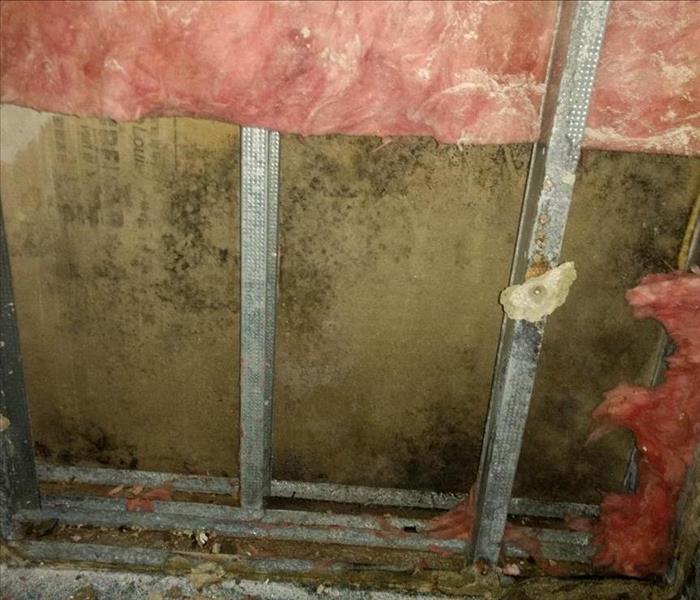 This wall took on serious mold damage. SERVPRO remediates any kind of mold problem!
This wall took on serious mold damage. SERVPRO remediates any kind of mold problem!
Everyone is aware of the dangers of mold, but do you know precisely what mold is and why it is dangerous? By understanding what mold is, you will have a better understanding of why it is so important to have professionals in Bedford County, PA handle mold cleanup. Additionally, you will know why black mold is so extremely dangerous.
Different Types of Mold
Mold comes in all shapes and sizes. Some of the most common varieties you will find in a commercial building include:
- Aspergillus
- Stachybotrys
- Cladosporium
- Serpula lacrymans
Mold is a type of fungus that typically results in discoloration, bad odors and a fuzzy appearance. To the naked eye, mold may appear dusty. The reason for this is that any kind of mold releases spores that enter the atmosphere. This is why you should avoid being in a room that has a significant moisture problem. Humans can breathe in the spores, and those spores can circulate throughout the rest of the building through the ventilation system.
Dangers of Mold Growth
If you are not careful, then fungus can quickly turn into black mold. The main different between these two variations is the type of spores they release. All types of mold produce toxins, but only more severe mold can product mycotoxins. These are organic compounds that are released directly into the surrounding atmosphere. As far as eliminating this mold, the solution will be the same as any other. Additionally, it is important to remember that while this variety is the only type that can produce mycotoxins, it does not necessarily mean it will automatically produce them once it has grown.
There is a lot of misinformation surrounding mold. If you have any questions whatsoever, then do not hesitate to get in touch with a professional black mold cleanup crew near you. You can have your commercial building inspected regularly to ensure mold never grows.
3 Tips for Preventing Mold Growth in a Rental Property
2/8/2022 (Permalink)
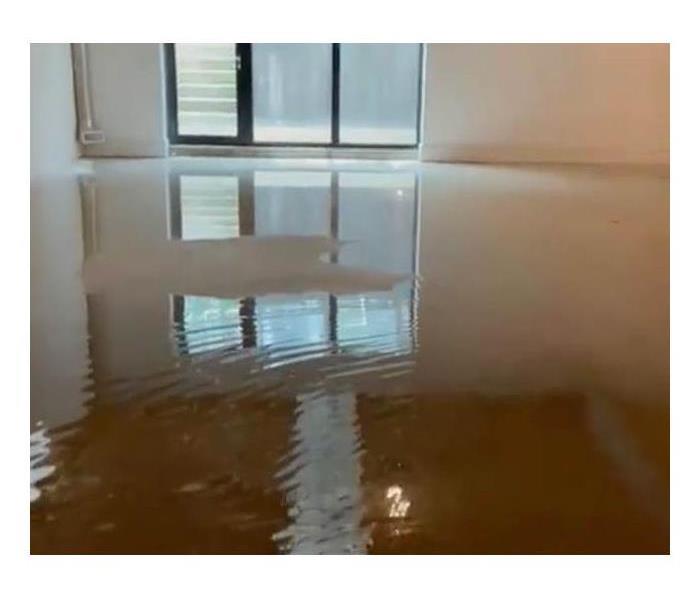 Storms can cause sever flooding, which can lead to mold growth. SERVPRO addresses the entire extent of the damage!
Storms can cause sever flooding, which can lead to mold growth. SERVPRO addresses the entire extent of the damage!
Whether you own a rental home or apartment complex in Bedford County, PA, you need to ensure your tenants have a safe environment. This means a house that is free of any water damage or mold growth. You, as the landlord, need to be proactive about mold prevention. It actually works in your best interest to prevent mold because you will save money and increase the chances of the tenants wanting to renew the lease.
1. Address Leaks Before Renting a Property Out
When you are between tenants in a property, you want to give the building a thorough inspection. During this examination, you should keep an eye out for any areas that are prone to leaking. This includes holes in the roof that could cause mold development in the attic. You also need to ensure the pipes are still in good working order. This kind of inspection should take place at least once annually.
2. Be Wary of Carpets
As the property owner, part of your mold prevention may require you to tear out carpets and replace them with hardwood. Even spilling a glass of water on a carpet can lead to mold growth. Even if only one area of the carpet has mold, the entire thing will need to be torn out, which can be costly.
3. Address Any Mold Immediately
It is unsafe for your tenants to be in a building with mold. Your tenants may even refuse to pay rent until the issue is handled. Therefore, you want to stay in the loop, and if your tenants tell you about a problem, then you need to take care of it immediately.
Mold prevention is much easier to handle than removal. In the event you do find mold in your rental property, you need to hire a professional crew right away so that your tenants will be happy and safe.
How To Deal With Mold Until a Professional Can Remove It
2/2/2022 (Permalink)
 SERVPRO can remediate any mold growth, like the one on this wall!
SERVPRO can remediate any mold growth, like the one on this wall!
In just 24 hours, mold can develop within your commercial building in Bedford County, PA. You need to address this right away before black mold starts to grow, which is much more dangerous. You should leave mold cleanup to the professionals, but it may take a couple hours for someone to come out. In the meantime, there are steps you can take to prevent the mold from escalating further.
1. Shut Off the Building’s HVAC System
You may see mold on drywall and assume it is localized. However, that patch actually releases various spores into the atmosphere, and they can spread to various parts of the building through the air conditioning system. However, it is still good to air out the affected room, and you can open up windows to promote circulation. Additionally, you can also bring fans into the room to promote adequate airflow.
2. Keep People Out of the Room
Whether there is black mold in the basement or a bathroom, you want to put up caution signs informing people to stay out until a professional comes. It is dangerous to be in a room with a significant moisture problem, and you do not want to put your employees in harm’s way.
3. Do Not Apply Bleach to the Mold
You may think you will be helping the mold cleanup crew by applying bleach to the affected area beforehand. For starters, bleach is not as effective at removing mold as most people think. In fact, there are some circumstances where bleach will actually exacerbate the problem. Bleach is also toxic, and you need to be wary of breathing in any fumes.
The best thing you can do when there is black mold in your building is to stay out of its way until a professional crew comes around. Mold is considered an emergency, so you probably will not have to wait long.



 24/7 Emergency Service
24/7 Emergency Service






